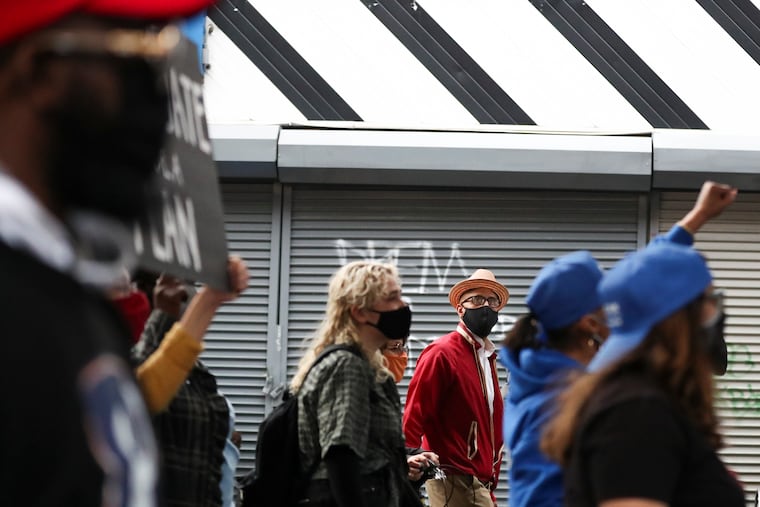As city leaders try to improve Kensington, they too often leave out community members
The city is constantly asking Kensington residents to do more — pick up trash, carry Narcan, join neighborhood watch — but we are rarely asked for our input on how to improve our neighborhood.

Every morning before leaving my house, I make sure that I have Narcan overdose reversal medication in my pocket. As I walk the two blocks to New Kensington Community Development Corp.’s office, and as I go about my day in my neighborhood, I am hyperaware that I may be needed to support someone having a mental health crisis or to intervene if someone is being victimized by crime. My day usually ends like it does for so many other tired residents — at community meetings where we are told the latest and greatest plans to improve our quality of life.
Kensington, like many divested neighborhoods in the city, has remarkable, dedicated residents who spend their time making it safer and cleaner. However, it is still amazing when I stop and think about the level of responsibility placed on residents of Kensington. We are cajoled into serving as sanitation workers, spending our weekends cleaning up messes we did not create just to be able to walk our streets or use our parks. We are asked to join efforts like town watch to serve as resident law enforcement. We carry Narcan. We are trained in things like trauma-informed practices and mental health first aid. And we are expected to show enthusiasm for community progress at meetings with institutions and organizations that have discovered solutions to our community’s challenges, none of which generally address the root causes of the region’s problems (such as poverty, lack of adequate housing, or poor education) that are uniquely affecting Kensington.
What is even more amazing is that, after being expected to serve as sanitation workers, law enforcement, paramedics, and mental health experts, residents aren’t included in decisions about strategic plans, money, or other resource allocation.
If participation is a ladder that we are all constantly climbing, here are the rungs: At the bottom are coercion and manipulation (nonparticipation). In the middle, there is informing, consultation, and engagement/placating (token participation). And the top rungs are codesign, coproduction, and citizen control (actual citizen power). In Kensington, residents too often are found at the lowest rungs of the ladder.
Over decades, decisions made for Kensington have been politically, economically, and professionally successful for the people who made them, but they have not made lasting improvements in the lives of Kensington residents. For example, beginning in 2017 the city of Philadelphia closed down several large encampments of unhoused people along Conrail tracks that run through the southern end of Kensington. According to the city, researchers found that “the encampments remained closed, making the pilot a success.” In 2018 the Zoning Board approved new $369,000 single-family homes now being sold against those tracks. At the same time, however, the number of unsheltered people and drug overdoses in Kensington increased dramatically. In addition to that increased suffering, many Kensington residents also feel less safe now than they did before the city took action.
Our city’s leaders should be looking for sustainable change and outcomes that mean something to the people who live here.
If leaders could value and share power with residents in a meaningful way, they could harness not just an intimate knowledge of the community, but the expertise the community has accumulated through years of direct experience. For example, in March 2021, SEPTA suddenly closed the Somerset El stop for repairs with no plan to reopen. In response, local residents, civic associations, nonprofits, and City Council members met with SEPTA and marched in solidarity with SEPTA workers to protest the unsafe conditions that have been allowed to plague Kensington Avenue and SEPTA’s poor planning that placed another burden on residents just trying to get to school or work. Because of this collective action, SEPTA saw its way to reopen the station two weeks later, as repairs continued.
» READ MORE: Mayor Kenney’s lack of involvement in Somerset El closure isn’t just a transit issue. It’s a leadership failure.
When answers to complex problems are created in collaboration and implemented by the people with the most at stake, the solutions are sustainable for the long term.
I recognize how difficult it is to build truly participatory frameworks, especially when trying to solve entrenched issues like poverty, housing instability, gun violence around the illegal drug economy, the dumping of construction debris, or neglected properties held by absentee real estate speculators. No one has the expertise to sit in every seat. But in a neighborhood like Kensington, everyone’s investment is needed. I am lucky that city leaders do occasionally reach out to me because of my title and affiliation. But without that, I would probably be treated like most other residents: an odd guy on the block who carries Narcan, will show up to clean the playground, and can be asked about city programs.
To solve the issues plaguing Kensington, everyone — politicians, nonprofit leaders, city officials, civic leaders, residents, and myself included — needs to do better. We can start by:
Reflecting on our own roles in maintaining the status quo and being willing to change.
Seeing communities as assets rather than deficits.
Aiming to let communities have control over what works for them.
Being more explicit in our goals so it’s clear that participation doesn’t stop with community planning, but includes community-led implementation and evaluation.
Kensington’s future success lies in harnessing the abundance of creativity, expertise, and determination across Philadelphia, rather than dictating solutions to the people who live in the community. Together, we can create sustainable change.
Bill McKinney is a longtime resident of Kensington and the executive director of New Kensington Community Development Corp. who holds a doctorate in urban applied anthropology.